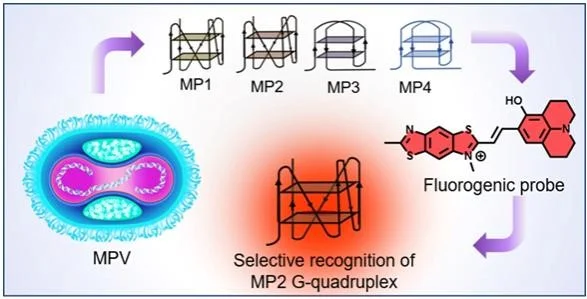Scientists Develop Precise Molecular Probe for Monkeypox Detection
Why in the news?
Researchers discovered unique G-quadruplex DNA structures in Monkeypox virus and developed a molecular probe for precise detection, advancing diagnostics and paving the way for antiviral therapeutics.
Breakthrough in Monkeypox Detection
- Scientists discovered a novel approach to study the Monkeypox virus (MPV) virology and develop advanced diagnostic tools and therapeutics.
- MPV, renamed Mpox, has been declared a Public Health Emergency of International Concern (PHEIC) twice in the past three years due to its rapid and unpredictable global spread.
- Understanding MPV’s transmission and symptoms is crucial for effective intervention.
Advancements in Diagnostic Techniques
- MPV, a double-stranded DNA (dsDNA) virus, is commonly detected through PCR, which amplifies dsDNA using fluorescent probes.
- Existing probes lack specificity, as they cannot distinguish between specific and non-specific amplification products.
- Scientists identified unique G-quadruplex (GQ) DNA structures in MPV—noncanonical nucleic acid conformations in guanine-rich sequences.
- A fluorogenic molecular probe (BBJL) was developed to selectively detect MPV-specific GQ sequences, ensuring precise identification.
- BBJL enhances fluorescence output 250-fold upon binding with MPV GQs and is non-fluorescent in the absence of target sequences.
Therapeutic and Diagnostic Implications:
- The GQ sequences in MPV are stable, conserved, and absent in other pox viruses or the human genome, making them ideal for diagnostics and therapeutics.
- The BBJL probe is part of a GQ-targeted diagnostic platform initially developed for COVID-19 detection.
- Scientists are mapping the MPV genome for additional GQ targets, potentially leading to new antiviral strategies.
- This innovation addresses limitations in current techniques, reducing false positives and enabling reliable MPV detection.
About Mpox:
- DNA virus from the Poxviridae family, first identified in monkeys in 1958.
- Spreads via animal-to-human and human-to-human contact, including sexual contact.
- Symptoms: Fever, headache, swollen lymph nodes, and rash after fever onset.
- Testing is done using PCR.
PHEIC and Mpox
- Declared a Public Health Emergency of International Concern (PHEIC) by WHO due to rapid global spread.
- Helps mobilise resources, enhance collaboration, and coordinate global actions.
Mpox in India
- First cases in 2022, with 27 confirmed cases and 1 death.
- Initial cases in Kerala from international travellers; later cases in Delhi without travel history.
Sources Referred:
PIB, The Hindu, Indian Express, Hindustan Times





